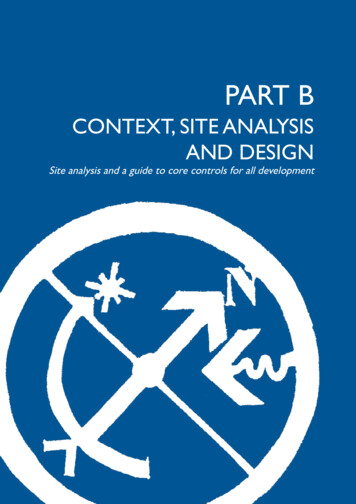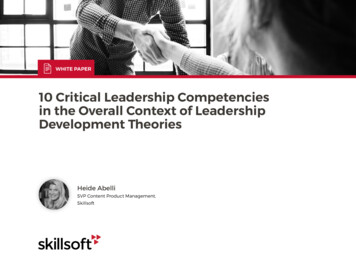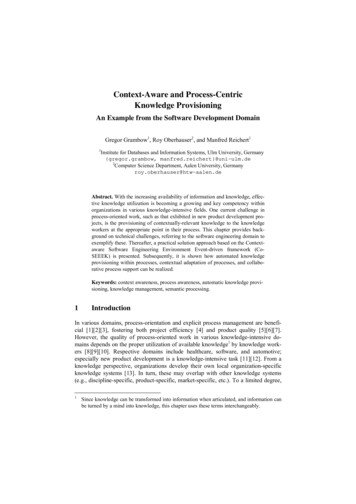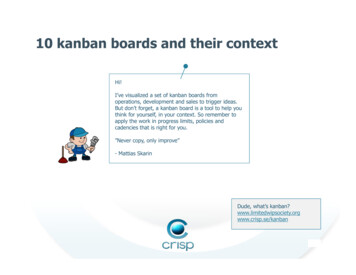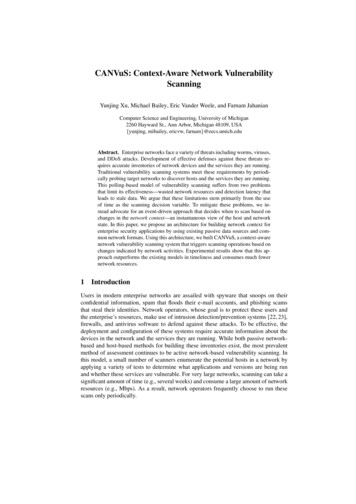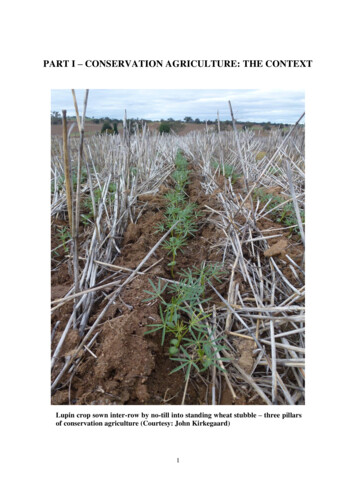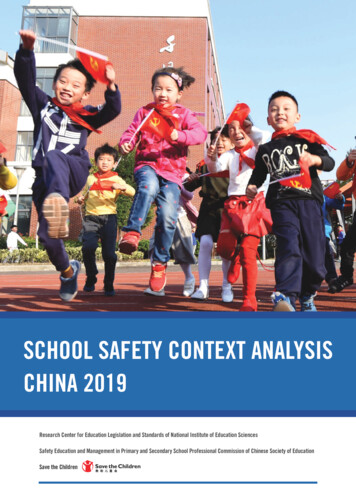
Transcription
SCHOOL SAFETY CONTEXT ANALYSISCHINA 2019Research Center for Education Legislation and Standards of National Institute of Education SciencesSafety Education and Management in Primary and Secondary School Professional Commission of Chinese Society of EducationSave the Children
SCHOOL SAFETY CONTEXT ANALYSIS CHINA 2019ACKNOWLEDGEMENTSSponsor:This report is funded by C&A Foundationthrough Save the Children.Version Completed in:December 2019AuthorsLeijun Ma: Vice Director of Research Center for Education Legislation and Standards ofNational Institute of Education SciencesXiaowen Fan: Asia Regional Child-centred Risk Reduction and School Safety TechnicalAdvisor, Save the Children(The following is the order of Chinese surname strokes)Yifei Ma: Assistant Researcher of Research Center for Education Legislation and Standardsof National Institute of Education SciencesJianzhou Wang: Post-doctor of Research Center for Education Legislation and Standardsof National Institute of Education SciencesXuren Wang: Assistant Researcher of Research Center for Education Legislation andStandards of National Institute of Education SciencesXiaonan Liu: Assistant Researcher of Research Center for Education Legislation andStandards of National Institute of Education SciencesLing Zhang: Post-doctor of Research Center for Education Legislation and Standards ofNational Institute of Education SciencesFang Qie: Assistant Researcher of Research Center for Education Legislation and Standardsof National Institute of Education SciencesWenjuan Zhou: Assistant Researcher of Research Center for Education Legislation andStandards of National Institute of Education Sciences
FOREWORDXiaohong Zhao: Vice Researcher of Research Center for Education Legislation andStandards of National Institute of Education SciencesShuang Xu: Master student of School of Education Science, Guangxi Normal UniversityHe Liang: Post-doctor of Research Center for Education Legislation and Standards ofNational Institute of Education SciencesYou Lu: Assistant Researcher of Research Center for Education Legislation and Standardsof National Institute of Education SciencesReviewed by:Xiaobing Sun: Pre-Director-General of Department of Policies and Regulations, Ministryof Education of China and Executive President of China Education Development StrategySocietyZengyi Zheng: Pre-Deputy Director-General of Department of Basic Education, Ministry ofEducation of China and Honorary Chairman of Middle and Primary School Safety Educationand Management Professional Committee, Chinese Society of EducationRunyong Yang: Director and Researcher of Research Center for Education Legislationand Standards of National Institute of Education SciencesWen Li: Professor of Beijing Institute of Education, and Chairman of Middle and PrimarySchool Safety Education and Management Professional Committee, Chinese Society ofEducationMarla Petal: Principal Advisor for Urban Resilience & School Safety, Save the ChildrenWith thanks to representatives from UNESCO, UNICEF, Plan International, World Vision,One Foundation, China Innovation Hub for Risk Reduction and Resilience in Education Sectoras well as Expert Working Group Members of Save the Children School Safety Project inChina, who have reviewed the report and provided constructive suggestions. With thanks toJiangfan Primary School of Zhangjiagang City of Jiangsu Province, School Safety EducationPlatform of Chinese Society of Education as well as Safety Homestead (emergency skills)training school, who have provided photos for the report.
SCHOOL SAFETY CONTEXT ANALYSIS CHINA 2019FOREWORDThe year 2019 marks the 40th anniversaryof China's 'Reform and Opening-up' policy.Over the past 40 years, China's economy hasmaintained a high speed of growth, and thecountry has made great progress in politics,economy, society and other aspects. In thiscontext, China's education has also madesignificant progress. In recent years, thepenetration rate of three-year preschooleducation has been on the rise, compulsoryeducation has been made universal, theproportion of vocational education hasincreased considerably, and the highereducation has reached the largest scale inthe world. At present, education at all levelsand of all types in China still maintains ahigh-speed growth momentum. China takeseducation as a cause of national priority,keeps increasing investment in education,and sets improving education quality andguaranteeing education equity as its goalsfor future development.Since the end of the 20th century, China hastaken school safety as an important workfor schools at all levels and of all types, andhas established stipulations for school safetywork in a number of laws, regulations andpolicy documents. In the past two decades,China has basically established institutionalframework of school safety managementin the education system at all levels, andhas established a school safety workingmechanism in all types of schools at alllevels, with the basic framework of safetyincident prevention, response and recovery.At present, in primary and secondary schoolsand kindergartens, there are generally asound safety responsibility system, safetyinstitutional system and safety educationsystem, and the school emergency plans anddrills for main hazards have also become acommon practice.Based on the work mentioned above, thesafety of the schools in China has beenimproved significantly; the probability ofserious school safety incidents has beenreduced; and the number of on-campus deathsof primary and secondary school studentsdue to accidents has been substantiallyreduced. However, it has been noticed thatthe occurrence of school safety incidents isof great uncertainty, and safety incidentsstill pose a serious threat to the schoolsand students in China. Therefore, in thefuture development of China's education,the following issues still need urgent attention:to improve the quality and profession levelof school safety work; to effectively preventthe occurrence of school safety incidents,and to ensure the physical and mental safetyand health of students on campus.In light of this background, we started todevelop the School Safety Context Analysis(China). This report is funded by Save theChildren, developed by researchers fromthe National Institute of Education Sciencesand other relevant institutions, and reviewed
FOREWORDby authoritative experts on school safety inChina and both domestic and internationaltechnical staff from Save the Children.This report introduces the relevant laws andregulations of China's school safety work,the common risks faced by China's schoolsafety work, and the progress and experienceof China's school safety work, etc. It aimsto help school safety related personnel tounderstand China's current school safetycontext, and also present the experienceand achievements of China's school safetywork to the world.It should be noted that the structure ofthis report is provided by the GlobalAlliance for Disaster Risk Reduction andResilience in the Education Sector, thereforesome systems and terms are relativelyunfamiliar to Chinese education staff,and we try to correspond and adapt theforeign language systems to the languagesystems used in China. In the meanwhile,adopting this international template alsoenables us to understand the dimensionsof international school safety work, whichis of positive significance for promoting thecommunications and cooperation betweenChina and other countries in the world inthe field of school safety.
SCHOOL SAFETY CONTEXT ANALYSIS CHINA 2019CONTENTS01Introductory Demographics & Socio-Political Context . 102Education Sector Overview . 403Hazards and Risks Overview . 2404Disaster Risk Management Overview . 3205Child Protection System Overview . 3906Comprehensive School Safety Overview . 4507Pillar 1: Safe School Facilities: Policies, Practices & Programs . 4908Pillar 2: School Safety Management & Educational Continuity: Policies, Practices &Programs . 6209Pillar 3: Risk Reduction and Resilience Education: Policies, Practices & Programs . 6910Child Protection & Conflict & Violence Prevention in Schools: Policies, Practices & Programs 74Appendices. 77Appendix 1 Major websites for reference. 77Appendix 2 Major school safety policies and laws in China . 77Appendix 2.1 Safety Management Measures for Primary and Secondary Schools andKindergartens . 77Appendix 2.2 Student Injury Accidents Coping Measures . 86Appendix 2.3 Guidelines for Public Safety Education in Primary and Secondary Schools 92Appendix 2.4 School Bus Safety Management Regulations . 99
CONTENTSAppendix 2.5 Interim Measures for Special Supervision of Major Emergencies inEducation .107Appendix 2.6 School Food Safety and Nutrition Health Management Regulations.110Appendix 2.7 Guidance for Emergency Evacuation Drill in Primary and SecondarySchools and Kindergartens .119Appendix 2.8 Advice on Strengthening the Building of Safety Risk Prevention andControl System for Primary and Secondary Schools and Kindergartens .125Appendix 2.9 A Letter to Parents of Primary and Secondary School Students Acrossthe Country .131Appendix 3 The number of times the national disaster relief and emergency responsewas launched (in 2018) .132Appendix 4 Themes of Safety Education Day for Primary and Secondary School Students.133Appendix 5. Summary table of school safety projects by civil society organizations.134Appendix 6. GADRRR-ES and WISS Ad Hoc Committee on Comprehensive School SafetyTargets and Indicators.137
SCHOOL SAFETY CONTEXT ANALYSIS CHINA 201901INTRODUCTORY DEMOGRAPHICS& SOCIO-POLITICAL CONTEXT1
01 INTRODUCTORY DEMOGRAPHICS & SOCIO-POLITICAL CONTEXTGeography and populationoverviewChina is located in the eastern part of Asiaand on the west coast of the Pacific Ocean.The territory is vast and the total area isabout 9.6 million square kilometers, rankingthe third in the world, almost equal to theentire area of Europe. The latitude of theChinese territory spans nearly 50 degrees,mostly in the temperate zone, a small partin the tropics, and no frigid zone. China'seast-west spans more than 60 degrees,and the easternmost Wusuli River and thewesternmost Pamir Plateau differ in fivetime zones.China's terrain is high in the west and low inthe east, and it is distributed in a staircase.Mountains, plateaus and hills account forabout 67% of the land area, and basins andplains account for about 33%. The distanceacross the country is about 5,000 kilometers,and the combination of temperature andprecipitation is diverse, forming a varietyof climates. The coastline of the mainland ismore than 18,000 kilometers, the coastlineof the island is more than 14,000 kilometers,and the water area of the inland sea andthe frontier sea is about 4.7 million squarekilometers. There are more than 7,600 largeand small islands in the sea area, coveringan area of 35,798 square kilometers. Theland borders 14 countries and is adjacentto six countries in the sea.China has more than 1,500 rivers with adrainage area of more than 1,000 squarekilometers.2STUDENTS(from primary school to higher education)270 millionFULL-TIME TEACHERS16.3 million13.9billionthe total population ofmainland ChinaBy end of 2017, the total population ofmainland China was 13.9billion. Amongthem, 270 million students received educationat all levels and of all types, and 16.3millionwere full-time teachers.
SCHOOL SAFETY CONTEXT ANALYSIS CHINA 2019Socio-political contextThe People's Republic of China was establishedon October 1, 1949. The National People'sCongress (NPC) is the highest state powerorgan of the People's Republic of China;the State Council is the executive organ ofthe NPC; the People's Court is the state'sjudicial organ; the People's Procuratorateis the state's legal supervisory organ; andthe Supervisory Committee is the state'ssupervisory organ.According to the Chinese Constitution,the administrative division of the People'sRepublic of China is as follows: the country isdivided into provinces, autonomous regions,and municipalities directly under the CentralGovernment; the provinces and autonomousregions are divided into autonomousprefectures, counties, autonomous counties,and cities; counties and autonomous countiesare divided into townships, ethnic townships,and towns. Municipalities and larger citiesare divided into districts and counties.Autonomous prefectures are divided intocounties, autonomous counties, and cities.At present, there are 34 provincial-leveladministrative regions in China, including23 provinces, 5 autonomous regions, 4municipalities, and 2 special administrativeregions. In history and custom, all provincialadministrative regions have short names. Theprovincial People's Government resident iscalled the provincial capital, and the seatof the Central People's Government is thestate capital. Beijing is the capital of China.China is a multi-ethnic country with56 ethnic groups including the Hannationality accounting for 91.5%; otherminority populations account for 8.5%.The characteristics of the distribution ofvarious ethnic groups in China are: largescattered, small settlements, and mixedliving. There are ethnic minorities livingin the Han area, and Han people living inethnic minority areas. The system of regionalethnic autonomy is a basic policy adopted bythe Chinese government in light of China'sactual situation and is also an importantpolitical system of China. As of 2017, atotal of 155 ethnic autonomous areas havebeen established nationwide, including 5autonomous regions, 30 autonomousprefectures, and 120 autonomous counties(banners).OTHER CGROUPS155ETHNICAUTONOMOUSAREAS3
02 EDUCATION SECTOR OVERVIEW02EDUCATION SECTOR OVERVIEW4
SCHOOL SAFETY CONTEXT ANALYSIS CHINA 2019Structure of the Education SystemChina's Constitution and the EducationLaw have made clear legal provisions onthe educational administrative system.The Constitution stipulates that the StateCouncil leads and manages education.Local governments at or above thecounty level shall, in accordance with law,manage educational undertakings withintheir respective administrative regions.Article 14 of the Education Law stipulates:"The State Council and local people'sgovernments at all levels shall lead andmanage education in accordance with theprinciples of hierarchical management anddivision of labor. Secondary and lower-leveleducation shall be managed by the localpeople's government under the leadershipof the State Council. Higher Educationis administered by the State Council andthe people's governments of provinces,autonomous regions, and municipalitiesdirectly under the Central Government."policies for education; drafting laws andregulations on education.According to the "Notice of the State Councilon the Establishment of Institutions", theMinistry of Education was established asa department of the State Council. TheMinistry of Education is composed by specificdepartments such as the General Office,the Policy and Regulation Department, theDevelopment and Planning Department,the Personnel Department, the FinanceDepartment, and the Basic EducationDepartment.4. To study and put forward the establishmentThe Ministry of Education has a totalof 17 responsibilities, including:2. To research and develop educationreform and development strategies andnational education development plans basedon research; to formulate policies for thereform of the educational system, as well asthe focus, structure and speed of educationaldevelopment, and to guide and coordinatethe implementation.3. Overall management of education fundingfor the department; to participate in theformulation of guidelines and policies forraising education funds, budget allocationfor education and education infrastructureinvestment; monitoring the financing and useof education funds throughout the country;to administer foreign educational aid andloans to China in accordance with relevantregulations.standards, basic teaching requirements andbasic teaching documents of secondary andprimary education schools of all types; toorganize the review and finalization ofthe state-compiled teaching materials forsecondary and primary schools; to guidethe reform of education and teachingin secondary and lower education; toorganize supervision and evaluation onthe popularization of nine-year compulsoryeducation and elimination of illiteracy amongyoung and middle-aged people.5. Overall management of general higher1. To research and develop guidelines andeducation, postgraduate education and5
02 EDUCATION SECTOR OVERVIEWhigher vocational education, adult highereducation, higher education operated bysocial forces, adult higher education selfstudy examination and continuing educationand other work; to study and put forwardthe establishment standards of institutionsof higher learning, and to examine theestablishment, name change, cancellationand adjustment of institutions of higherlearning; to formulate the catalogue ofdisciplines and specialties and basic teachingdocuments; to guide the reform of educationand teaching in institutions of higher learningand the evaluation of higher education; tobe responsible for the implementation andcoordination of 'Project 211'1.6. To plan and guide the education of ethnicminorities and coordinate educationalassistance to ethnic minority areas.7. To plan and guide the work of partybuilding in institutions of higher learning,as well as ideological and political work,moral education, physical education, healtheducation, art education and national defenseeducation in all types of schools at all levels.higher learning; to be responsible for themanagement of student records of varioustypes of higher education; to administerthe reform of the employment system forcollege graduates, formulate employmentpolicies for college graduates, and organizeand implement employment distribution forcollege graduates.10. To plan and guide the research of naturalsciences, philosophy and social sciences ininstitutions of h
Xiaowen Fan: Asia Regional Child-centred Risk Reduction and School Safety Technical Advisor, Save the Children . Runyong Yang: Director and . penetration rate of three-year preschool education has been on th
